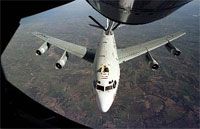In the first reports released since North Korea announced its underground nuclear test on Monday, both U.S. and Chinese officials announced that they found no evidence of a nuclear blast in the air above the North Korea test site. In a later report, a U.S. official claimed that scientists did have preliminary evidence of a nuclear blast.
Even if experts did not detect the airborne particles that would normally result from a nuclear incident, that doesn't mean no nuclear blast has occurred. This lack of evidence can mean any number of things:
Advertisement
- No nuclear blast occurred.
- A nuclear blast occurred, but it was exceptionally small and/or partially unsuccessful.
- The underground blast was completely contained (a pretty unlikely event).
- The blast was not completely contained, but the testing was done before the underground crater collapsed to form an opening at the surface of the test site, releasing radioactive particles into the atmosphere.
On Tuesday, one day after the reported test, the United States sent up a "sniffer" airplane to test the skies over North Korea for radiological evidence of a nuclear event. The airplane that performs this task is the WC-135 Constant Phoenix, an "atmospheric collection aircraft" that runs regular patrol missions to back up the Limited Nuclear Test Ban Treaty of 1963. According to the U.S. Air Force, this sniffer plane has "external flow-through devices to collect particulates on filter paper and a compressor system for whole air samples collected in holding spheres." The plane's technology includes analysis equipment that provides results in real-time, so if radioactive particles are present in the air, it's known immediately as the plane flies over a specific location.
So, what exactly is the WC-135 looking for in its atmospheric testing? It's looking for ionizing radiation -- radioactive isotopes, specifically various xenon isotopes, that are characteristic of a nuclear event and only a nuclear event. They are produced in the act of nuclear detonation, resulting from the fission activity that produces the explosion (see How Nuclear Bombs Work). It's not just atmospheric explosions that produce this radioactive fallout; underground and underwater nuclear tests almost always leak these particles into the air. A fully contained nuclear blast is a rare event (see Is it possible to test a nuclear weapon without producing radioactive fallout?).
While atmospheric testing can't pinpoint the exact location of a nuclear blast, it can declare that the blast absolutely took place if it finds the characteristic ratio of xenon isotopes in the atmosphere. That finding is considered an absolute nuclear signature.
Another method of detecting a nuclear blast is by seismograph, the device that monitors Earth tremors to pinpoint and analyze earthquake activity (among other ground-shaking events). There's actually a whole network of 500 seismograph stations positioned around the world whose job is to report ground-shaking incidents, and that includes any evidence of bomb blasts. NPR's "Detecting Underground Nuclear Blasts" reports that the seismic activity recorded on Monday indicated a ground disturbance that would be the equivalent of a 4.2 magnitude earthquake. That magnitude indicates a blast with about a 1-kiloton yield, which is equal to the power of 1,000 tons of TNT.
Figuring out if a seismic event is an earthquake or a bomb blast is relatively easy. Scientists perform analyses of wave patterns that can accurately confirm an earthquake-versus-explosion determination. In highly simplified terms, in an earthquake, the ground starts shaking slowly as plates slide against each other, and then the seismic activity slow picks up as the ground really starts to move. In an explosion scenario, the initial blast is extremely powerful, and the subsequent shaking of the ground grows progressively less severe. But figuring out it's a blast and not an earthquake is only part of the process; seismographs can't really determine if the blast was nuclear or conventional in nature. Also, it's possible to "hide" a nuclear blast, for instance by detonating it in a tremendous underground cavity, which decreases the effects on the ground because the blast's energy goes into compressing all that gas in the huge hole. These limitations in the seismograph system make atmospheric testing a necessary component in the detection system.
For more information on nuclear bombs, radioactive fallout, nuclear-blast detection methods and related topics, check out the links on the next page.
Advertisement

